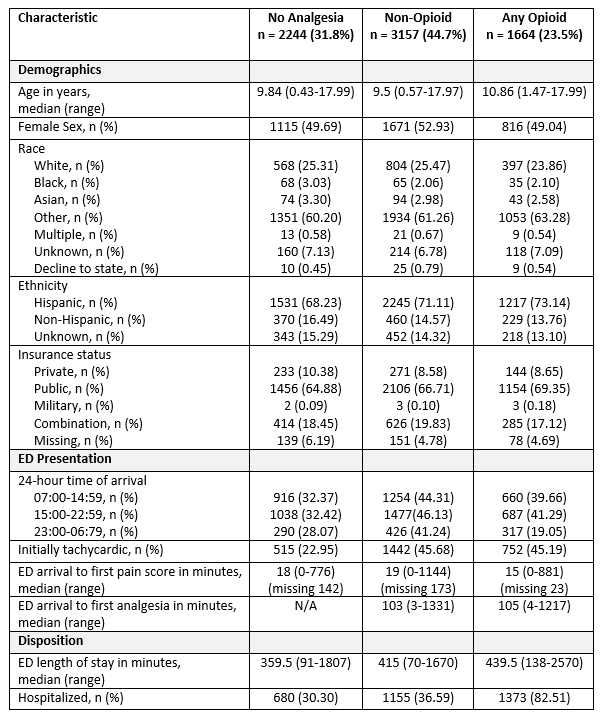Emergency Medicine: All Areas
Emergency Medicine 12
496 - Pain management in children with suspected appendicitis in the Pediatric Emergency Department
Publication Number: 496.311
- GM
Gabriela Moriel, MD (she/her/hers)
Pediatric Emergency Medicine Fellow
Children's Hospital Los Angeles
Hacienda heights, California, United States
Presenting Author(s)
Background:
Early and appropriate pain management is an important aspect of emergency care in children. Abdominal pain is one of the most common presenting symptoms in the pediatric emergency department (ED) with appendicitis being the most common surgical emergency. Administration of analgesia, including opioids, has not been shown to delay the diagnosis of appendicitis. Yet, administration of analgesia during the diagnostic workup of suspected appendicitis remains variable.
Objective:
To determine the proportion of any analgesia and opioid analgesia administration, and median time to first analgesia administration, in patients evaluated for appendicitis in the ED.
Design/Methods:
We conducted a retrospective, single-center cross-sectional study of children < 18 years of age evaluated in the ED from June 2014-June 2021 for suspected appendicitis, defined as completion of complete blood count and ultrasound of the appendix. Data were abstracted from the electronic health record. Our primary outcome was administration of analgesia, specifically non-opioid and opioid analgesia. Our secondary outcome was median time to first analgesia administration from time of arrival. Pain scores were categorized into mild (1-3), moderate (4-6), and severe (7-10). Descriptive statistics and Chi-squared test were used to compare proportions and timing of analgesia administration.
Results: During the 8-year study period, 7065 eligible children were evaluated for appendicitis. Overall, 4821 (68.2%) received some form of analgesia and 1664 (23.6%) received opioid analgesia during their ED visit (Table 1). Median time to any analgesia administration overall was 104 minutes (n= 4821) and median time to opioid analgesia was 105 minutes (n= 1664). Pain scores were significantly associated with both non-opioid and opioid analgesia administration (p < 0.001). However, among patients who did not receive any analgesia during their ED visit, 1226 (54.6%) had pain scores in the moderate or severe range.
Conclusion(s):
Analgesia administration in children with suspected appendicitis varies considerably, even with pain scores in the moderate or severe range on initial assessment. Efforts to target more consistent and timely pediatric pain management practices are needed, which can be accomplished through directed nursing and physician quality improvement interventions.
.png)
